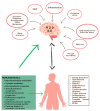Exploring the Relationship between Mood Disorders and Coexisting Health Conditions: The Focus on Nutraceuticals
- PMID: 37759862
- PMCID: PMC10526332
- DOI: 10.3390/brainsci13091262
Exploring the Relationship between Mood Disorders and Coexisting Health Conditions: The Focus on Nutraceuticals
Abstract
Major depressive disorder and bipolar disorder are the leading causes of global disability. Approximately 50% of patients fail to attain remission, prompting a pronounced focus on the significance of dietary patterns and specific nutrients within the pathophysiology of mood disorders. The connection between chronic diseases and mood disorders follows a bidirectional pattern: physical ailments are interrelated with affective disorders, and, concurrently, mood symptoms often precede chronic diseases and have the potential to worsen their prognosis. Nutraceuticals affect factors that could potentially impact the onset of mood disorders: monoamines and brain-derived neurotrophic factor (BDNF) concentrations, neuroinflammation, oxidative stress, and sleep quality. Furthermore, mood disorders rarely manifest in isolation. Typically, such patients concurrently experience other mental disorders or somatic comorbidities: obesity, hypertension, diabetes, polycystic ovary syndrome (PCOS), etc., where providing nutritional support is also pertinent. To optimize the therapeutic approach for individuals with mood disorders, incorporating nutritional support may not solely ameliorate symptoms stemming directly from the mental condition, but also indirectly through interventions targeting comorbidities.
Keywords: bipolar disorder; comorbidity; major depressive disorder; nutraceuticals; nutritional support.
Conflict of interest statement
Agnieszka Mechlińska has no conflict of interest. Mariusz S. Wiglusz has received research support from Alkermes, Biogen, Janssen, KCR, Otsuka, and Servier. Jakub Słupski has received research support from Actavis, Eli Lilly, Minerva, Sunovion, Celon, Janssen, Biogen, and Novartis. Adam Włodarczyk has received research support from Actavis, Eli Lilly, Minerva Neurosciences, Sunovion Pharmaceuticals, KCR, Janssen, Otsuka, Apodemus, Cortexyme, and Acadia. Wiesław J. Cubała has received research support from Acadia, Alkermes, Allergan, Angelini, Auspex Pharmaceuticals, BMS, Celon, Cephalon, Cortexyme, Ferrier, Forest Laboratories, GedeonRichter, GWPharmaceuticals, HMNC Brain Health, IntraCellular Therapies, Janssen, KCR, Lilly, Lundbeck, Minerva, MSD, NIH, Novartis, Orion, Otsuka, Sanofi, and Servier; Honoraria from Adamed, Angelini, AstraZeneca, BMS, Celon, GSK, Janssen, KRKA, Lekam, Lundbeck, Minerva, NeuroCog, Novartis, Orion, Pfizer, Polfa Tarchomin, Sanofi, Servier, and Zentiva; Advisory board position with Angelini, Celon (terminated), Douglas Pharmaceuticals, Janssen, MSD, Novartis, and Sanofi.
Figures


Similar articles
-
Letter to the Editor: CONVERGENCES AND DIVERGENCES IN THE ICD-11 VS. DSM-5 CLASSIFICATION OF MOOD DISORDERS.Turk Psikiyatri Derg. 2021;32(4):293-295. doi: 10.5080/u26899. Turk Psikiyatri Derg. 2021. PMID: 34964106 English, Turkish.
-
Clinician guidelines for the treatment of psychiatric disorders with nutraceuticals and phytoceuticals: The World Federation of Societies of Biological Psychiatry (WFSBP) and Canadian Network for Mood and Anxiety Treatments (CANMAT) Taskforce.World J Biol Psychiatry. 2022 Jul;23(6):424-455. doi: 10.1080/15622975.2021.2013041. Epub 2022 Mar 21. World J Biol Psychiatry. 2022. PMID: 35311615
-
Right care, first time: a highly personalised and measurement-based care model to manage youth mental health.Med J Aust. 2019 Nov;211 Suppl 9:S3-S46. doi: 10.5694/mja2.50383. Med J Aust. 2019. PMID: 31679171
-
[Antipsychotics in bipolar disorders].Encephale. 2004 Sep-Oct;30(5):417-24. doi: 10.1016/s0013-7006(04)95456-5. Encephale. 2004. PMID: 15627046 Review. French.
-
The soft bipolar spectrum redefined: focus on the cyclothymic, anxious-sensitive, impulse-dyscontrol, and binge-eating connection in bipolar II and related conditions.Psychiatr Clin North Am. 2002 Dec;25(4):713-37. doi: 10.1016/s0193-953x(02)00023-0. Psychiatr Clin North Am. 2002. PMID: 12462857 Review.
References
-
- World Health Organization. [(accessed on 25 March 2023)]. Available online: https://www.who.int/news-room/fact-sheets/detail/mental-disorders.
-
- Nestsiarovich A., Reps Jenna M., Matheny Michael E., DuVall S., Lynch K., Beaton M., Jiang X., Spotnitz M., Pfohl S.R., Shah N.H., et al. Predictors of diagnostic transition from major depressive disorder to bipolar disorder: A retrospective observational network study. Transl. Psychiatr. 2021;11:642. doi: 10.1038/s41398-021-01760-6. - DOI - PMC - PubMed
Publication types
LinkOut - more resources
Full Text Sources

